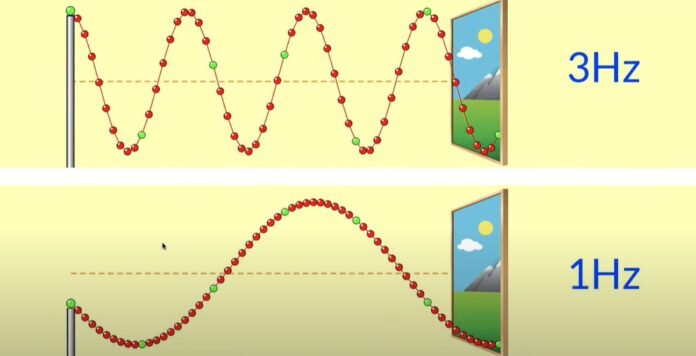Introduction
Waves are the movement or flow of energy between two points without the movement of matter. Whenever waves of any kind (such as water or sound waves) move through a medium, they manifest as oscillations; otherwise, they don’t (in the case of electromagnetic waves). Both their apparent and invisible manifestations are all around us. Radio waves, sound waves, and other wave patterns are a few examples.
What is Wave?
This definition’s key point is that a wave is a disturbance or fluctuation propagating through a medium. Although the wave may cause some small-scale vibrations within the medium it travels, the particles in the medium do not move with the waves. The disturbances could be a sine wave with an indefinite length or a pulse with finite width.
Types of Waves
Mechanical Waves
Since sound and water waves are mechanical, they must move via a medium. The wave’s speed is determined by the material characteristics of the medium it moves through, which could be a solid, liquid, or gas. Light, which is not a mechanical wave, can go across a vacuum, including the voids of space. The water wave is a well-known wave that you can easily picture. Water waves are caused by disturbances within the water’s surface, such as those caused by swimmers splashing the water frequently or tossing a rock into a pond.
Pulse Waves and Periodic Waves
A pulse wave is a sudden disruption in which only one wave or a small number of waves are produced, as in the pebble instance. Pulse waves are also produced by thunder or explosions. A periodic wave is connected to simple harmonic motion when it repeatedly oscillates over some time, just like in the case of a wave pool. Each particle within the medium moves back and forth frequently via the same places, resulting in simple harmonic motion in periodic waves.
Longitudinal Waves and Transverse Waves
Mechanical waves can be classified as either transverse or longitudinal waves depending on their motion. You should note that longitudinal and transverse waves can both be periodic. The disruption of a transverse wave perpetuates perpendicular to the direction of propagation. A longitudinal wave, in contrast, has a disturbance that runs parallel to the path of propagation.
Waves can be longitudinal, transverse, or a combination of the two. Transverse waves include electromagnetic waves like visible light and also the waves of musical instrument strings. Both water and air have longitudinal sound waves. Periodic pressure changes, which are communicated through fluids, cause disruptions.
Wave Characteristics
- A wave causes a medium’s particles to oscillate somewhat around their mean positions, but they do not move permanently along the direction of the wave’s propagation.
- Each consecutive particle of the medium moves in the same way as its predecessors, either parallel to or perpendicular to the wave’s direction of propagation.
- Only energy, not a portion of the medium, is transported through wave motion.
Properties of Waves
- Amplitude:- Transmission of energy takes the form of waves. A wave’s height, often expressed in metres, is its amplitude. It is proportional to the amount of energy a wave carries.
- Time:- The duration of a vibrational cycle for a particle in a medium makes up the period of a wave. The period is calculated in minutes or seconds because it is a unit of time.
- Frequency:- The frequency of a wave is the number of waves that pass a particular location in a fixed amount of time. The frequency is measured in hertz (Hz), representing one wave every second.
- Speed:- An object’s speed is defined as how swiftly it moves and is typically expressed as the distance travelled divided by the journey time. The wave’s speed is defined by the distance covered by a particular location here on the wave (the crest) in a set length of time. Thus, the speed of a wave is expressed in metres per second and m/s.
Recommended Articles:
Weathering Types I Physical, Chemical & Biological
What are Eddy Currents? Definition, Used and Systems
What Are Energy Bands?
What Is Force Types Of Forces And Their Nature
Internet History of the internet Overview & Timeline
The fact that waves transmit energy rather than matter is among the most crucial things to remember. They vary from other physics phenomena because of this. Like microwaves, as well as radio waves, many waves are invisible. Lituya Bay in Alaska had a 1,720-foot-tall ocean wave that was the largest one that has ever been measured. The wind is the primary factor in wave formation. Wind-driven waves, sometimes referred to as surface waves, are created by friction between the wind and the water's surface. A wave crest is produced as wind continuously disturbs the water's surface on a lake or an ocean. Water moves in a circular motion due to energy travelling through it, creating waves. Never has always been the ocean. We anticipate seeing waves on the horizon, whether from the beach or a boat. Water moves in a circular motion due to energy travelling through it, creating waves. The creation of waves is influenced by wind, gravitational attraction, as well as water movement. We often see waves produced by the wind. But there are also waves produced by gravitational forces (such as tidal waves) and undersea disturbances like earthquakes (e.g. tsunamis). Wind speed, wind duration, or how long the wind blows, and fetch—the distance over water that the wind blows in a particular direction—all impact wave height. Small waves only occur when the wind moves slowly, regardless of the fetch or length of the wind. Waves I Definition, Types, Characteristics and Properties FAQs
What is the most crucial aspect of waves?
How is a wave produced?
What is your understanding of waves?
What three processes result in waves?
What are the four key elements that influence a wave's size?
